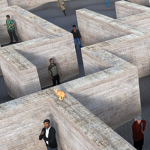
Mariusz Pisarski takes us on a detailed tour through the cognitive intricacies of hypertext classic Victory Garden's migration from Storyspace (circa 1992) to the Web. In so doing, Pisarski observes how years of Stuart Moulthrop’s experience as a mentor and teacher of digital literature, and as a practicing hypertext scholar and writer, are built into the anniversary edition of Victory Garden.
Victory Garden 20221Stuart Moulthrop, Victory Garden 2022, reconstruction made in Electronic Literature Lab by the team of: Stuart Moulthrop, Dene Grigar, Arlo Ptolemy, Andrew Thompson, Holly Slocum, Austin Gohl and available at: https://victory-garden2022.com. , one of the latest web reconstructions of e-literary classics made by the Electronic Literature Lab, delivers a promise of yet another 20 years of exploration of this vast hypertext. Created in Storyspace and originally published in 1993 by Eastgate Systems, Stuart Moulthrop’s hypertext fiction achieved a status of a unique, literary evergreen2Traversal of Stuart Moulthrop’s “Victory Garden,” Part 1 (2020), “Rebooting Electronic Literature vol.2: Documenting Pre-Web Born Digital Media, (eds) Dene Grigar, Nicholas Schiller at al), online https://scalar.usc.edu/works/rebooting-electronic-literature-volume-2/traversal-of-stuart-moulthrops-victory-garden, a wide ranging digital ouvre3Raine Koskimaa, Reading Victory Garden: Competing Interpretations and Loose Ends, in: Rebooting Electronic Literature Volume 3: Documenting Pre-Web Born Digital Media, (eds) Dene Grigar, https://scalar.usc.edu/works/rebooting-electronic-literature-volume-3/reading-victory-garden-by-raine-koskimaa?path=stuart-moulthrops-victory-garden. The dense network of interconnected text spaces (993 lexias and over 2800 links) delivered an abundance of divergent stories that run in parallel or, sometimes, in contradiction to each other. Add to this some blind alleys and “secret” spaces, and the result is an electronic labyrinth, a garden of forking paths not only in a postulated, metaphorical sense, but in a manner that is embodied into the mechanism of reading and experienced in interaction with the text. Being inspired by Jorge Luis Borges’ “Garden of Forking Paths” and its mind-bending theme of possible worlds in the context of the First World War, Victory Garden successfully managed to propel Borgesian motifs into contemporary context of modern wars and modern technologies. This makes Moulthrop’s fiction highly relevant at any time and its full migration to the Web amounts to one of the most important e-literary events of the year 2022.

The Web version was made in open web technologies, mainly JavaScript and jQuery, and with the latest tricks that will ensure the work’s long life4Grigar, Dene (2022) Reconstructing Stuart Moulthrop’s Victory Garden, “The Digital Review” Issue 02, https://thedigitalreview.com/ . This longevity is something Stuart Moulthrop specialises in (his Hegirascope, for example, has been accessible on the Web without interruption since 1995). Professional backend and beautiful front-end is also something that ELL lab stands for as a leading place for electronic literature preservation. As a result, readers of the renewed Victory Garden are treated with a high standard of hypertextual production. A trademark of Mouthrop’s visual repertoire, characters and landscapes created in Maya 3, was used extensively in the reconstruction. Authorial illustrations abound, and because they benefit from the aerie, surreal, often underpopulated visual vignettes of the 3D modelling software, they are never too literal and manage to successfully complement the linguistic realm. Some of the sequences, such as the new Stream “Persons” are narrated almost entirely visually. Finally, we are able to see the many characters and narrators of Victory Garden not only in our imagination, but as they are seen and rendered by the author. Bridging the lush illustrations and the minimalist text areas is the golden color of interface elements and links, along with the upscaled maze diagram from the original’s title page. The gold is the color of sand that relates to real places, such as the Iraqi desert and US military bases in the Gulf, and to places of imagination: the “unreal” Uqbar, which – as Moulthrop reminds us after Borges – “is brought to you by the people who invented Tlön, a conspiracy to replace the bad old world with a novus ordo saeculorum.” A feeling of both continuation and renewal permeates throughout our initial encounter with the reconstructed Victory Garden. At times, especially when immersed in reading, one could forget that it is not from the original Storyspace hypertext. At other times, when reflecting on the text or orientating ourselves, the refreshed interface, introduction of some new reading mechanisms and the updated system of thematic groupings make Victory Garden 2022 even more of what it has been: a hypertext experience which is different and more rewarding every time we read it.
Few things have changed considerably when compared with the original. The links are now visibly marked in the text and only those words that are active can be followed. No Tinkle and Bell keys (option + command) are needed to see “words that yield.” For contemporary readers, accustomed to conventions of the Web and social media, it is a welcome change. One would say, why hide links if they were put there in the first place, or why every word can be clicked if most will lead to the same page? Truth be told, readers of the original Victory Garden might miss the element of unexpected semantic clashes of scenes, places and motifs that occur after clicking a word that is not a link, although you do not know about it. For example, while reading about Thea when she considers asking Harley to borrow some trousers for her son Leroy, but for the sake of Veronica, gives up on the idea, I may want to know who Harley and Veronica are, I may click on their names to check it. In the 1993 version it is not obvious if “Harley” or “Veronica” are links. In the 2022 version it is clear they are not. In the first case, the reader would go to the default destination (next segment in the sequence) and – confusingly – think that what they read is somehow related to Harley or Veronica. In the second case, thanks to the visible link anchors, marked in Uqbar sand gold, we cannot even click on their names. These cognitive intricacies of Storyspace migration to the Web are not limited to Victory Garden. Online editions of Figurski at Findhorn on Acid (2021)5Figurski at Findhorn on Acid (The Web Edition). The NEXT, https://the-next.eliterature.org/works/1102/0/0/. and Twilight. A Symphony (2022)6Michael Joyce, Twilight. A Symphony (2022). A reconstruction by Mariusz Pisarski, Michał Furgał and Łukasz Podgórni, https://archive.the-next.eliterature.org/joyce/twilight/. bring the same change, although Figurski… preserves the Tinkle and Bell link triggering mechanism as a legacy feature7Pisarski, Mariusz (2021) The new Figurski… – Blueprints for Media Translation, http://dtc-wsuv.org/wp/ell/2021/07/14/the-new-figurski-blueprints-for-media-translation/. . Nevertheless, when hypertext classics migrate to the Web, they need to speak the language of the Web. Importantly though, just as in Twilight. A Symphony, “page turning” type of navigation, made possible in Storyspace by pressing the return key and famously labelled by Michael Joyce as “the wave of returns” has been preserved in Victory Garden 2022 and even given some new features. As Moulthrop informs us in “READ ME (and How) “, pressing the enter key continuously activates a special, consequently linear path of reading (called “Garden”) that will take the reader through all 44 chapters of the novel, from the beginning to the end. Sven Birkerts would be overjoyed!8Birkerts, Sven (2006) The Gutenberg Elegies: the Fate of Reading in an Electronic Age, Faber and Faber.
Another important change introduced in the of the online edition of Victory Garden is the redesigned navigation. In its original form it closely resembled the minimalistic navigation toolbar of Michael Joyce’s afternoon. a story. This resemblance stretched even to the yes and no buttons of afternoon. Having its origins in the famous “do you want to hear about it?” question at the end of the introductory scene of afternoon, these buttons were slightly redundant in Victory Garden which did not ask its readers for a direct yes or no response. No wonder that future editions of Victory Garden, especially those for Windows machines, opted for even more simplified “rose-wind” navigation interface. In the 2022 edition, the “rose-wind” concept has been beautifully expanded into a mysterious and complex device, reminiscent of some ancient construct straight from Borges’ stories, an artefact buried deep under a ruined desert temple and known only by few obscure Arabian scholars.
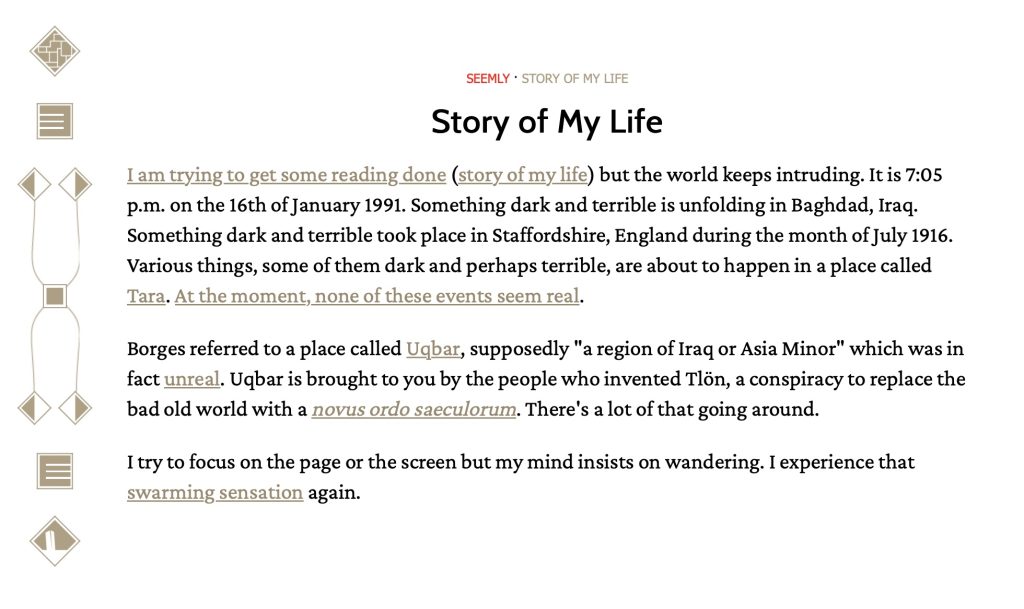
Nine elements of the toolbar deliver 5 different ways of accessing the work and navigating along its paths and streams. The uppermost section of the toolbar directs to the
well-known Map of the Garden. Just as in the original, it offers entry points to important parts of the work. The square in the center ensures that the README page is at hand, and the diamond at the very bottom offers a restart option. In between are navigation devices related to the two important concepts that the new Victory Garden wants to familiarize its readers with: Paths and Streams. The Paths, a category familiar to hypertext scholars, constitute thematic clusters of this polyvocal narrative network. The paths such as “Alone”, “Where were you” and “Upside down” were present in the Storyspace version, but their list in the 2022 edition has been expanded. The Streams are larger chunks of the whole, like chapters in a book. The introduction of Streams strengthens user friendly experience of the new edition. If we ever get tired with open ended traversals enabled by links, more traditionally oriented parts of our brain may be satisfied with some closure and coherence offered by Streams. The presence of Paths and Streams, and the reader’s current standing with them, is marked in a special heading of each lexia that consists of two titles. The left title signals a Path on which the reader is currently situated, the right title – a Stream. Path and Stream labels marked in red signal an active sequence; the result of the reader’s previous choice saved in the browser’s cache. This is a small, but smart device, a new system introduced in the Web version, that makes Streams and Paths – to use Moulthrop’s own words - “patient.”
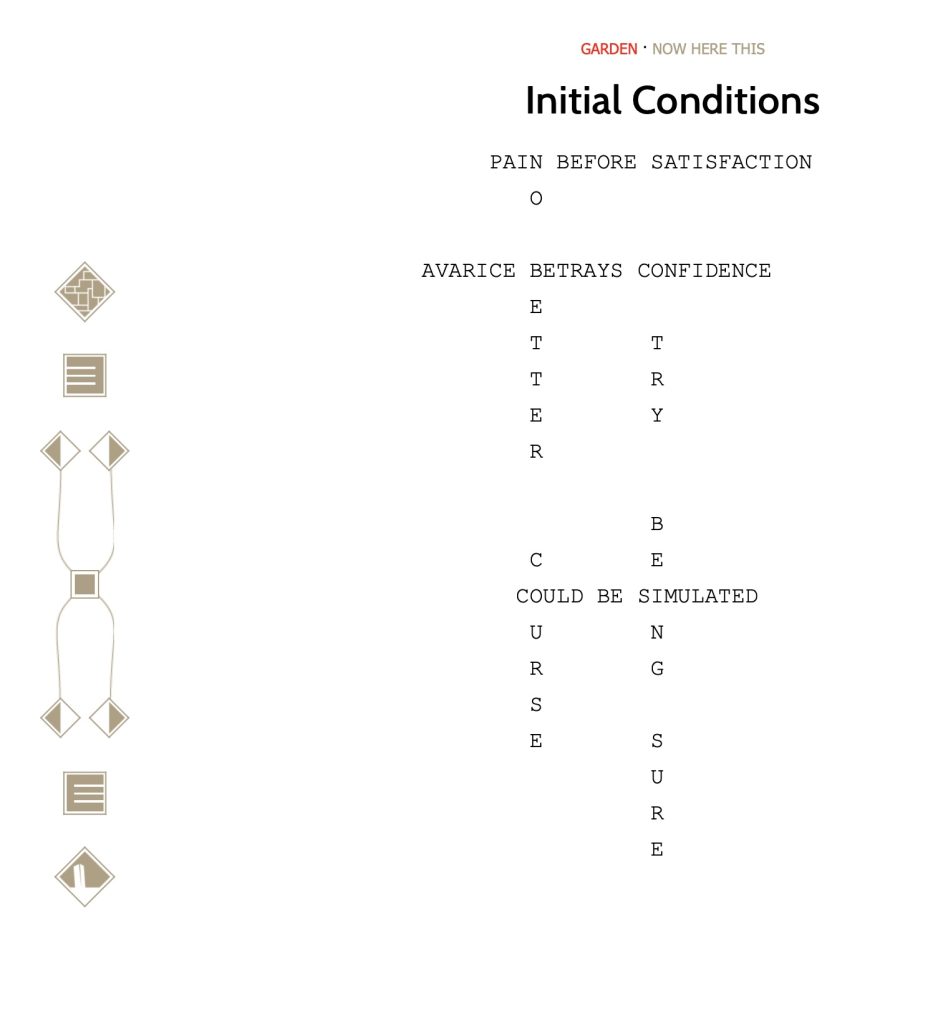
This seemingly simple device that tracks our current place within the network of stories solves two problems at the same time. Firstly, it compensates for the lack of visual mapping of the hypertext structure that Storyspace was known for. Although the feature was not present in the original Mac edition of Victory Garden, the Web reconstructions of Figurski at Findhorn on Acid and Twilight. A Symphony paved a way for a possible re-imagining of Storyspace maps by any Web migrations of the Eastgate classics, a road that Victory Garden 2022 did not take. Secondly, it solves a paradox of many visual tools for narrative structures which tend to reveal certain information while concealing some other. In Storyspace, seeing the current lexia on the map reveals its position on the layer of the map that it belongs to, also displaying any neighbors on that layer. The same map view however, will not show links outside of the current hierarchy level, nor the “roadmap” (a network context of inbound and outbound links), nor the containers of the node, obscuring its thematic affiliation. In Victory Garden 2022 these issues are addressed in a clever way, and with minimum resources. Once we learn that the first element of the headline is a Path, and the second is a Stream, and that the active state of each indicates our trajectory that we can return to by using directional arrows, we have an inventive orientation tool at our disposal. Links are still “diving boards into darkness”9Moulthrop, Stuart (2021) "Hypertext Fiction Ever After." Electronic Literature as Digital Humanities: Contexts, Forms, & Practices. By James O’Sullivan. New York,: Bloomsbury Academic, 154 Bloomsbury Collections. Web. 29 Aug. 2022 . and we can do as much of non-sequential hopscotching as we please, but at any moment a single key stroke takes us back to a chronologically organized group of nodes (a Stream) or a semantically affiliated narrative vignette (a Path). Years of Stuart Moulthrop’s experience as a mentor and teacher of digital literature, and as a practicing hypertext scholar and writer, are built into the anniversary edition of Victory Garden. Navigational apparatus and main concepts that help us traverse this dense network of stories are – at least in theory – closer to mapping the three dimensionality of hyperspace than many visual tools.
On the title page of the new Victory Garden readers are offered 5 choices: to click / press the “begin”, to read by Streams or Paths, to enter via the Labyrinth, or to start at random. Entering via the Labyrinth re-enacts the original Labyrinth: an emerging sequence of words that – after a series of binary choices made by the reader – form a full sentence. A sentence might read: “In the labyrinth America where everything is what we want right now.” On each turn of this reader-selected sequence, a parallel display of words in the heading delivers an alternative message, in my case: “Come in Labrys: America the Land of Little Seeming.” Dynamic text effects were Moulthrop’s specials and started as early as his first Hypercard works such as Hyperbola. A Digital Companion to ‘Gravity’s Rainbow’ (1991) or DreamTime (1992). Parallel texts were flashing out and disappearing, crawling under or around the text screen. The Labyrinth section in the original Victory Garden, apart from offering readers a metonymic and symbolic construction of their own paths in the mini - labyrinth, was a successful exercise in text animation in the relatively static environment of Storyspace, something that Michael Joyce also did with his “shrapnel” sequence leading out of the introductory scene of afternoon. a story. On the Web, the dynamism of the labyrinth is somehow lost, along with the productive confusion effect of the parallel message. It is lost perhaps because the visual minimalism of the black and white text windows and navigation elements afforded a more focused reading; perhaps because of the speed of transitions between lexias that the stand-alone system of Storyspace offered. On the Web, the presence of visual link anchors and the need to refresh the page before going to another screen makes the experience somehow less smooth and less focused. It feels no better, no worse, just different.
Differences that result when a work moves across platforms and across time are much more prominent than those between editions in the print world, where the platform – a printed page – remains largely unchanged. This difference is a defining feature in the process of migrations of electronic literature as more and more reconstructed works appear.10Dene Grigar (2022) Reconstructing Hypertexts (keynote), HT ’22: 33rd ACM Conference on Hypertext and Social Media, June 28 – July 1, 2022, Barcelona (Spain) Regardless of the scope of changes, they are in themselves a reason to celebrate any new edition because even if someone perceives the difference as a loss, there will also be gains. In the case of Victory Garden, readers have the privilege of having the author as a careful curator of changes. The added value they introduce often means additional content! I’ve mentioned the illustrations, the Streams and the updated list of Paths. More added content is found along the two remaining protocols of reading: the default path and random generation of text and images.
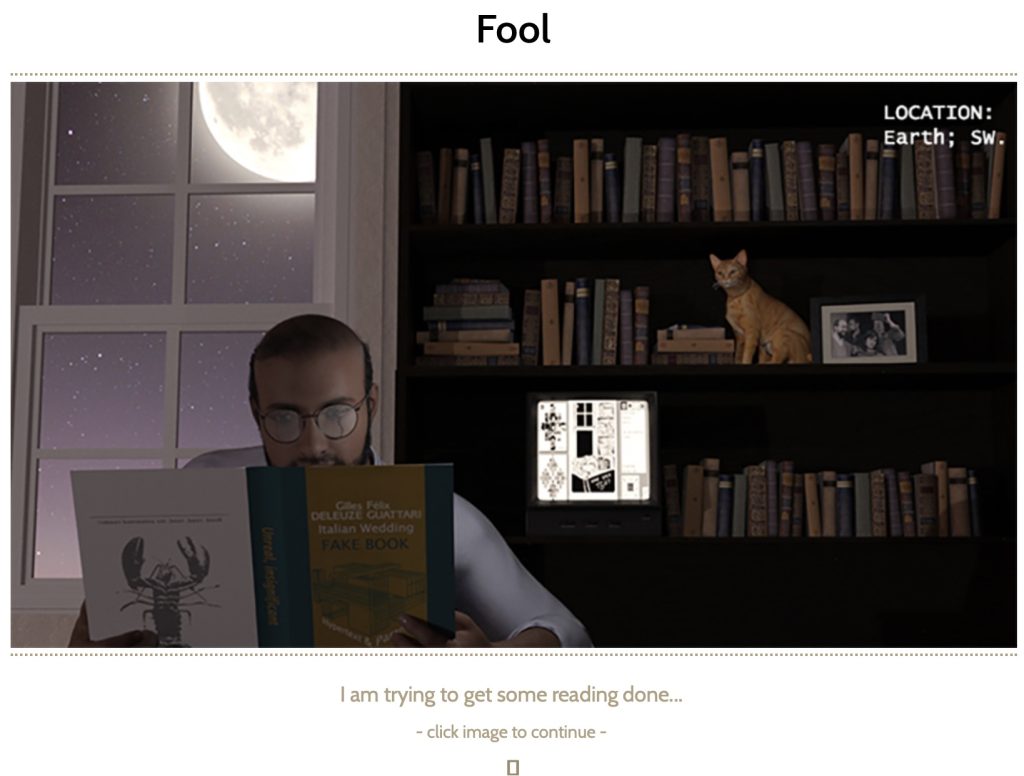
The default path leads to a lexia called “Fool” that initiates the main “Garden” Path and the Stream called “Story of my life.” It features a Maya rendered version of the author, or his alter ego, in his library, reading a fictional book by Deleuze and Guattari titled “Italian Wedding.” “I’m trying to get some reading done” - we read. Before we click on the image to proceed, our attention is driven to the background of the authors’ study. On the bookshelf, a ginger cat sits by a famous black and white photo of members of the TINAC salon (Nancy Kaplan, Moulthrop, Joyce and John McDaid). On the shelf below, an electronic work, made possibly in Hypercard, blinks on a screen of a small, old monitor. The metaphor of a stack of cards representing content on the digital screen, something that Hypercard used in its name and in its functionalities (lexias of Hypercard were grouped in stacks) features prominently on that screen. The largest stack in the middle presents a drawing of a character reading a book. It mirrors Moulthrop’s Gauttari and ago reading the “Italian Wedding.” The stack features some navigational elements. The portion on the left of the screen displays two stacks of actual cards. They do not belong to the standard 52-card pack but to a Tarot deck (the image is not clear but one could think of a Juggle or Magician from the Major Arcana and cups or wands from the Minor Arcana). If the character with an open book from the main stack of the Hypercard fiction reflects the author in his library, and the author reflects us, readers, then the cards in the Hypercard work reflect the content of our reading. Importantly though, the main character of this little mise-en-abyme structure is labelled a “Fool.” The Fool card is the number 0 of the Major Arcana and signifies the beginning of an adventure of unlimited possibilities. It is also us, readers, who embark on such a journey. However, the “Fool” is a new addition to the Victory Garden 2022. No lexia of such a name exists in the original, although the sentence “I’m trying to get some reading done” does. It comes from the “Story of my life” – the title of the next lexia in sequence and the whole Stream. Do these additions indicate an esoteric bottom to the new edition? More hidden patterns, Easter eggs, tiny but crucial polishes? Yes to all! The new Victory Garden is wider, deeper and more sparkling than ever before.
The last method by which Victory Garden reveals its forking paths and secrets is a random one. Readers can click the random link on the intro page and jump right into the unknown. It’s an exciting feeling to draw – in a blink of a second – a chance lexia from the deck consisting of a thousand – a luxury that was not possible in the Storyspace version available to Moulthrop at the time of publishing the hypertext in 1991 (random links were introduced to Storyspace by 1995). Randomness is especially effective for seasoned readers who might encounter familiar scenes in different contexts, Paths and Streams that were perhaps missed, and some rare, hidden places. At any moment, though, we can go back to a more structured reading via the wind-rose. Along with the simple, on-click random access, Victory Garden 2022 introduces a subtle machinery of randomness and renewal on the loading screen. Each time the work is loaded, a cover illustration from selected Streams is displayed, a nice touch to have the experience different each time we want to read, and a hint at what to read at the same time.
CONCLUSIONS
Victory Garden embarks on its journey to contemporary readers through a landscape entirely different from that of 20 year ago. Electronic literature has matured into a field of diverse practices, platforms, and communities. Perhaps none of them is taking a center of the field in a way that hypertext fiction did in the early 90-ies. Tiny computational poems that generate mind bending numbers of its own variations, often with the help of big data and linguistic commons; bots and memes distributed on social media; smartphone apps that incorporate geo and bio data of users into their content; immersive worlds of wonder and dread experienced within VR environments – all of these deliver their artistic, literary message in their own way and on their own terms. Reconstructed and updated hypertexts such as Victory Garden bring even more variety to such a vibrant field. Two decades after the Golden Age of hypertext, relieved of hypertext’s ill-perceived mission of replacing print or being a major blue-print for e-literature, the 21st century hypertexts excel at what they were really good at: delivering a fiction that changes every time we read it, presenting possible worlds and alternative endings, drawing three-dimension contours of structures that “we know we have seen only after we move over them.11Joyce, Michael (1995) What Happens as we go, in: Of Two Minds, Ann Arbour: The University of Michigan Press, p. 207”Approaching it as an “indeterminate heap of contradictory drafts”, the Borgesian tongue-in-cheek formula that Moulthrop likes to quote, enfeebles the outcome. Victory Garden 2022 is a hypertext storytelling at its finest!
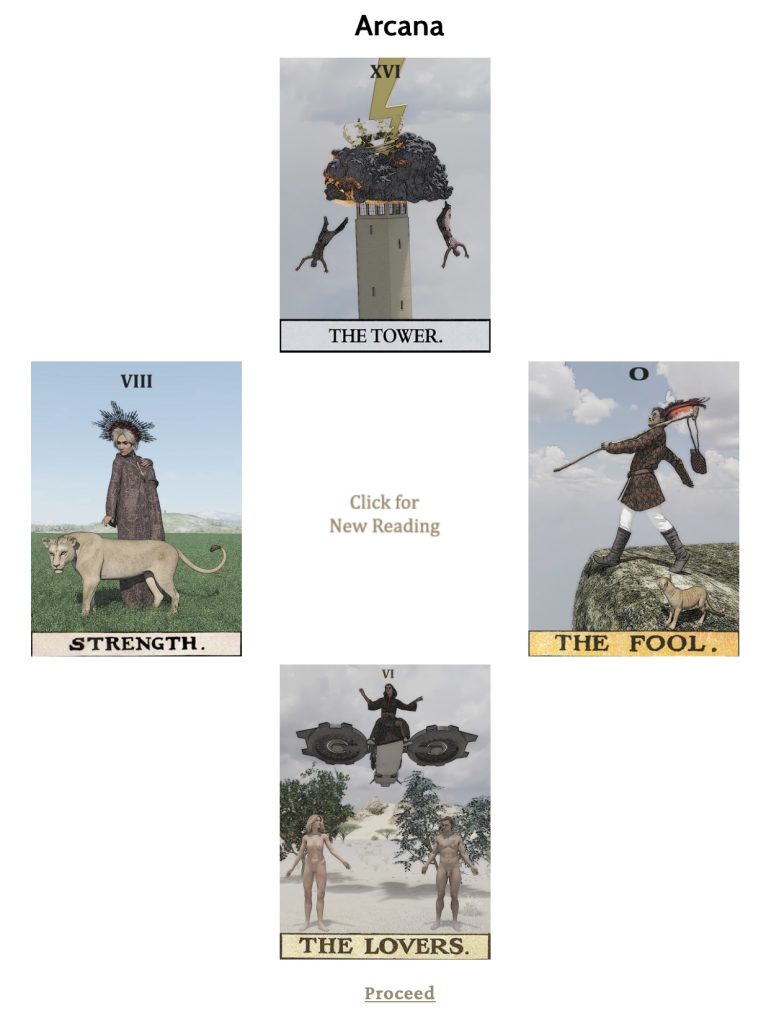
The original audience of Victory Garden, those who knew it when it first appeared and those who read it after it was already well situated in the Hypertext Hall of Fame will love the 2022 edition. It’s better than ever, sprinkled with additional content, with plenty of illustrations, random effects, and new modes of reading. New readers are presented with a prime example of what literature on the Web, and on the screens of our mobile reading devices should be: a place to come back to for years to come. The original Victory Garden intended to be a literary evergreen, a network of stories that seem never to exhaust themselves, intertwine and tangle differently each time we enter. The new edition, a project of a small team of young preservationists from the ELL lab who worked with the author for 6 months, achieves this goal with means appropriate for our contemporary technological milieu. The result is an engaging, organic, contemporary hypertext fiction that I truly hope will find its new followers and will inspire similar literary projects on the Web (and post-Web). In terms of renewable content, Moulthrop’s reconstruction, recreation and update to his classic fiction might not match bots, memes and generated poetry’s wit and light-speed delivery, but beats these forms on authorial intent and curation, with an added plentitude of intertextual rumbas, corpora of fascinating characters, scenes, and stories. These compelling narratives written in enjoyable language paint a portrait of America that is – for better or worse – timeless and universal. And, as Michael Joyce always wanted for hypertext fiction, these stories, and this portrait, are different each time we read it. Victory Garden 2022 is the hypertext for the 21st century.